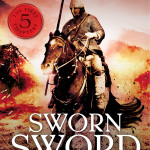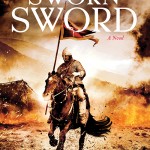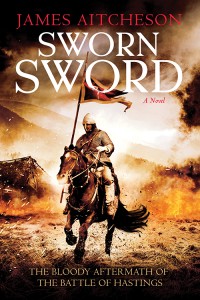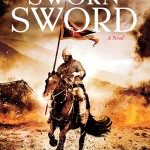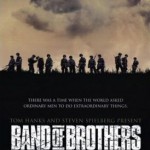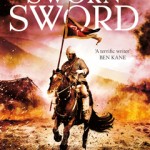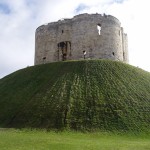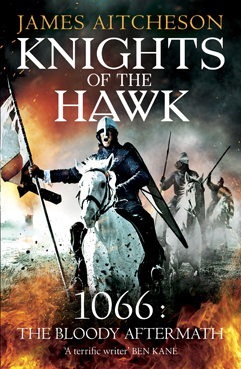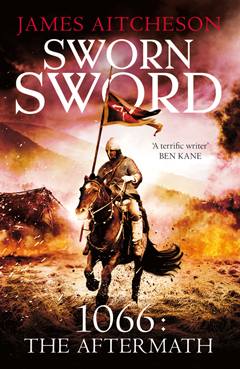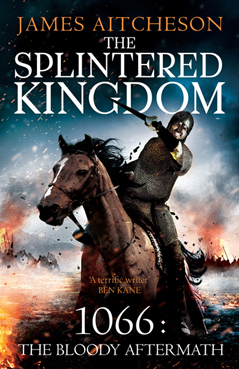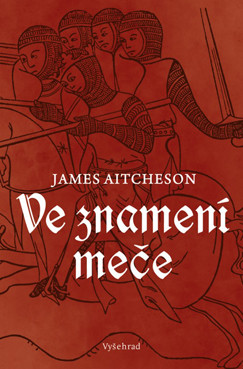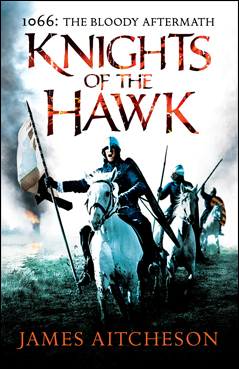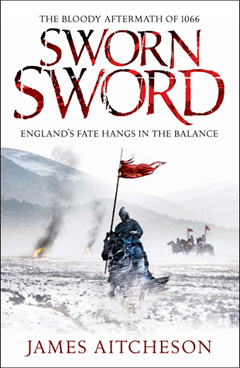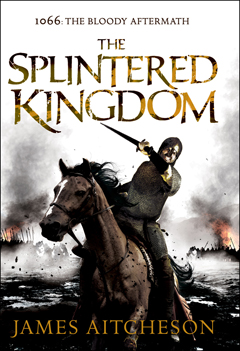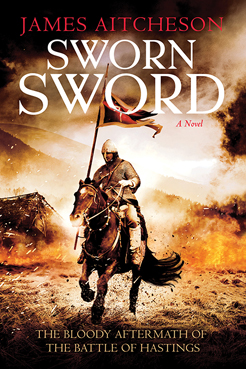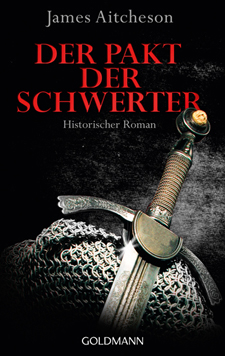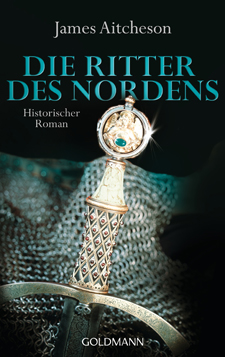Tell your friends! Today, the brand new paperback edition of Sworn Sword will be hitting bookshelves across the United States. Featuring an updated, more vibrant cover design (similar to the UK paperback cover; see below right), it also contains a short excerpt from the sequel, The Splintered Kingdom, which is due to be published this August and of which I’ll be posting more details here in the next few months.
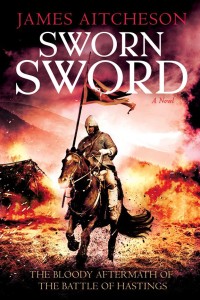
Sworn Sword • James Aitcheson • Sourcebooks Landmark • 400 pp.
Trade paperback • $14.99
I’m pleased to say, as well, that Sworn Sword has been picking up excellent reviews since its hardback publication last summer, including one in Publishers Weekly and another recently in the Philadelphia Inquirer. Thanks to all those of you who have kindly taken the time to email me through the Contact page or sent messages on Twitter and Facebook to say how much you’ve enjoyed the book and are looking forward to Tancred’s further adventures. He and his brothers-in-arms will ride again in the not-too-distant future!
If you already own the hardcover edition of Sworn Sword and can’t wait until August to find out where Tancred’s travels will be taking him in The Splintered Kingdom, you can find the synopsis as well as the first chapter, which is available to download for free, here.
The Normans are coming! Not content with conquering England, they now have their sights set on the USA as well…
And their campaign begins today with the Stateside release of Sworn Sword in both hardcover and eBook editions, courtesy of the hard-working people at my publisher Sourcebooks Landmark, who have done an absolutely fantastic job of making the book a reality.
As readers in the UK already know well, Sworn Sword is the first instalment in the Conquest Series, which tells the story of the violent and treacherous years immediately following the Norman invasion of England in 1066, when rebellion gripped the kingdom and its fate hung in the balance. As will become clear, the fateful Battle of Hastings was not the end of the struggle for England; in fact, it was just the beginning.
Based on real-life events, the series follows the career of the ambitious young knight Tancred, who is hungry for battle, for glory and for vengeance after his lord is murdered by English rebels. To find out more, have a look at the cover blurb and download the first chapter from Sworn Sword to whet your appetite.
The second in the series, The Splintered Kingdom, will be published in the US in summer 2014, followed by Knights of the Hawk in summer 2015, so there are plenty of Norman Conquest-related adventures to look forward to! As always, I’ll be posting the latest information about the novels as and when I have it, so keep checking back from time to time to see what’s new.
Based on real-life events, Sworn Sword tells the story of the great rebellions that swept England in the years after 1066, as seen through the eyes of a Norman knight named Tancred, who seeks vengeance after his lord is killed by English rebels.
Published by Sourcebooks Landmark, it’ll be available from all good bookstores and, of course, online as well, in both hardcover and eBook editions. Here’s the full synopsis:
January, 1069. Less than three years after the Battle of Hastings in 1066 and the death of the usurper, Harold Godwineson, two thousand Normans march in the depths of winter to subdue the troublesome province of Northumbria. Tancred a Dinant,a loyal and ambitious knight, is among them, hungry for battle, honor, silver, and land.
But at Durham, the Normans are ambushed in the streets by English rebels, and Tancred’s revered lord Robert de Commines is slain. Badly wounded, Tancred barely escapes with his own life. Bitterly determined to seek vengeance for his lord’s murder, the dauntless knight quickly becomes entrenched in secret dealings between a powerful Norman magnate and a shadow from the past.
As the Norman and English armies prepare to clash, Tancred uncovers a cunning plot that harks back to the day of Hastings itself. If successful, it threatens to destroy the entire conquest-and change the course of history.
This stunning debut sweeps readers into a ruthless, formidable world, where violent warriors seek honor in holy places and holy men seek glory in dark deeds. As the two opposing forces battle for conquest, the fate of England hangs in the balance.
Battles and betrayals abound, and there’s also a touch of romance, too – something, I hope, for everyone. And if that’s whetted your appetite, here’s the first chapter to give a further taste of what’s in store.
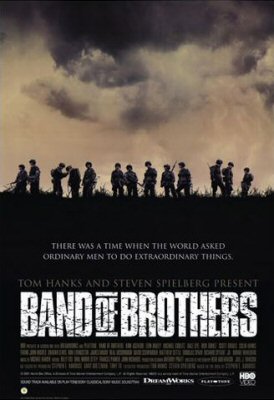
Promotional poster for the Second World War miniseries Band of Brothers, which was originally broadcast in 2001.
We few, we happy few, we band of brothers;
For he to-day that sheds his blood with me
Shall be my brother …
– William Shakespeare, Henry V, Act IV Scene iii
The idea of the “band of brothers” is central to Sworn Sword. The opening encounter at Durham sees Tancred’s conroi (the basic Norman cavalry unit, usually composed of around twenty men) shattered and his lord killed at the hands of Northumbrian rebels. Only two of his fellow knights, his close friends Eudo and Wace, survive to help him carry the stain of that defeat. The close group of warriors he once belonged to, who ate and trained and joked and fought together, is no more.
What happened to the real survivors of Durham is not recorded in the primary sources that mention the battle; indeed it is rare that the chronicles offer much by way of insight into the feelings of the people whose fates they record. Still, it is possible to imagine the grief and guilt and sense of loss those survivors had to bear, and the thoughts of revenge they must have harboured.
To capture a full sense of what it means to be part of such a tight-knit combat unit, I sometimes look to similar depictions elsewhere in fiction. One of the best portrayals I’ve come across is in the TV miniseries Band of Brothers. I first saw this series when it was originally shown in 2001, and watched it a second time a few years back when I was in the early stages of writing the novel that would become Sworn Sword.
With the second book, The Splintered Kingdom, now completed and my thoughts already turning to the next instalment of Tancred’s story, I went back to view the series on DVD again this week. Each time I’ve come to it with new eyes, and each time I’ve been able to take something away from it that either adds to my understanding of the hardships of war, or gives me ideas for fresh avenues to explore or new ways to depict the ongoing conflict that was the Norman Conquest in my writing.
The “band of brothers” of the series’ title is Easy Company of 2nd Battalion, 506th Parachute Infantry Regiment in the 101st Airborne Division of the U.S. Army. Over ten episodes we follow the exploits of the various characters – all based on real-life individuals – who make up the company, from their early training to Operation Overlord, and from there through Operation Market Garden and the Battle of the Bulge to the occupation of Germany at the end of the war.
The over-arching narrative of the 1944-5 campaign in Western Europe bears some similarities to that of the Norman Conquest. The series of operations which led from the Normandy landings to Berlin was long and arduous; progress was sporadic and frequently subject to German counter-offensives. Just as D-Day was only the beginning in June 1944, so the Battle of Hastings proved merely the opening engagement, albeit a highly significant one, in the Conquest.
Even though nearly 900 years separate the Second World War from my own period, there’s still a lot that can be learnt from Band of Brothers, not least regarding the experience of war and the psychology of those individuals who make it their business to fight. It’s fascinating to follow the journeys of the various characters and see how they each respond to the situations they find themselves in, and face up to challenges both physical and emotional.
We see green and untested volunteers develop into seasoned and skilled campaigners. Some appear to be natural warriors and born leaders, and find themselves in their element from the start, while others take time to find their feet. Some are strengthened by their experience of the war; others find themselves consumed by it, to the point where in order to make it through they sacrifice some of their humanity. One thing they have in common is that they are all changed by what they have seen and done.
War exacts its toll upon the individual in different ways, as I hope The Splintered Kingdom will show. As the battle for England intensifies and the kingdom falls under siege on all sides, the Normans’ grip on their hard-fought gains grows ever weaker, and in the middle of the struggle Tancred finds his resolve put to the test as never before.
Today the paperback of Sworn Sword hits the bookshelves! You’ll notice it has a brand new cover design (see bottom left), which really captures a sense of the drama contained within its pages and which I’m sure you’ll agree looks just as – if not more – striking than the original. Keep a look out for it in bookshops and supermarkets across the country.
The paperback also contains a sneak peek of the first chapter from the sequel, which is due out in hardcover and in all electronic formats this September. The title, I can reveal, will be The Splintered Kingdom. You heard it here first! More details, including the blurb and of course a picture of the jacket design, to follow in the not too distant future.
I’ll be signing copies of the Sworn Sword paperback in Waterstones in Hereford on Saturday 21 April, and I’m adding more dates to the calendar all the time, so keep checking my Events page to see if I’ll be appearing in your area in the coming months.
Also, if you’re a German speaker, look out for Der Pakt der Schwerter, which is set to be released on 17 April. Find out more on the website of my German publisher, Goldmann, and even read an excerpt.
Sworn Sword | Paperback | RRP £6.99 | Arrow | ISBN: 978-0-099-55941-2
Last week I ventured northwards to York for the annual Jorvik Viking Festival. For the 27th year, Norsemen took over the city for February half-term week and set up camp in the streets, even bringing their longship into Coppergate Square for those queueing up outside the Jorvik Viking Centre to admire.
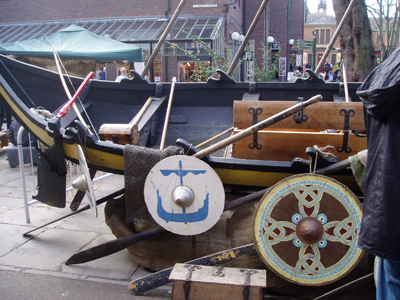
The Viking longship in Coppergate Square, outside the Jorvik Viking Centre.
I was in York to talk about Sworn Sword, the novel’s connection with the city, and what it was about York that made it such a battleground during the mid-eleventh century as English, Norman and Scandinavian forces all struggled to capture and control it. At the end I also gave a special sneak preview reading from the very first chapter of the sequel, which will be released in hardcover on 6 September (more details on that to follow soon).
York has a long history dating back to the Roman period. By the time of the Norman Conquest it was the second biggest city in England (after London): the chief town of the north of the kingdom; a major manufacturing centre for metalwork, woodwork, glass and jewellery; and a burgeoning port and trading hub with links all across Europe and beyond, even as far as Byzantium and Samarkand in modern-day Uzbekistan. In 1069 when Sworn Sword is set it would have been a fantastically vibrant place to be, with people from all cultures mixing together and a lot of wealth being brought in from abroad.
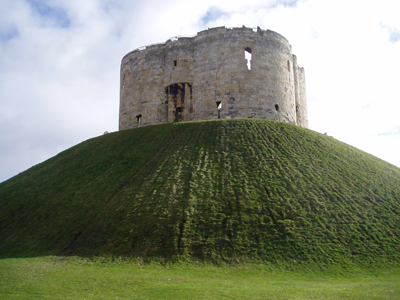
Clifford's Tower, York - the thirteenth-century keep that stands on the site of the original castle.
Militarily speaking, York was also a crucial strong-point, and whoever controlled it tended to hold sway over the vast province known as Northumbria that stretched from the Humber Estuary in the south to the borders of the Scottish kingdoms in the north.
For that reason it formed the location for some of the fiercest struggles for power witnessed in this period, both before the Conquest – the Battle of Stamford Bridge, for example, which was fought only a few miles away between the namesake kings Harold Godwineson of England and Harald Hardrada of Norway – and afterwards too. It’s not too much of an exaggeration to say that York was where in many ways the future of England was decided in those fateful years.
I visited the city a few years ago as part of my research for the novel, so that I could get a feel for the scale of the medieval city and the lie of the land. Not much of Conquest-era York survives today, but by walking the streets I was able to get a feel for the richness of the place’s history. On my return last week I also took the time to snap some pictures, the best of which you can see on this page!

The ruins of St Mary's Abbey outside Bootham Bar to the northwest of medieval York.
One of the locations that I revisited last week was St Mary’s Abbey (pictured above), the ruins of which now lie in the Yorkshire Museum Gardens. St Mary’s was in its turn built on the site of an earlier foundation dedicated to St Olave in a district once known as Earlsburgh, which it is suggested received its name from a fortified palace belonging to the Anglo-Scandinavian earls of Northumbria that used to stand nearby.
That palace is the same one referred to in Sworn Sword as the residence of the real-life vicomte (sheriff) of York, William Malet, who was installed by King William I after the city was first captured by the Normans in 1068. Even though the site looks very different nowadays, somehow the knowledge that I was treading the same ground as my characters helped me visualise those scenes when I came to write the novel.
Thanks to the folks at York Archaeological Trust and the Jorvik Viking Centre for inviting me to come and talk. It was a pleasure to meet so many other historically-minded people and to share my love of this period. I hope it’s not too long before I find myself back in York. And for those of you reading this who have a special interest in all things Norse-related, the good news is that there are more Vikings to come in Books 2 and 3 – watch this space!
*
For information about other Viking- and medieval-themed events taking place in and around York, visit the Jorvik Viking Centre website.

